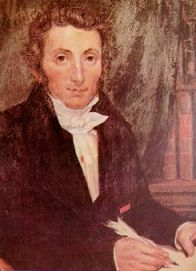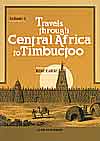|
Il diario di viaggio è una delle testimonianze più significative e palpitanti di quel periodo- l' Ottocento - in cui gli europei andavano ad esplorare ogni angolo dell'Africa per porre le condizioni del loro dominio.
Rene Caillié, ragazzo proveniente da un villaggio contadino nel quale gli echi del mondo borghese arrivano tardi, anche dopo la rivoluzione, benché in maniera nuova e forse più incisiva.
Sicuramente il mito dell' esploratore è un mito borghese, come è vero che l' Europa trionfante in quel periodo è un' Europa borghese, e con forti propensioni al successo economico-industriale.
Andare a Timbuctu diventa la sua grande aspirazione, il suo grande sogno, la sua fissazione, torbida, demenziale: la mitica, leggendaria città sahariana, la "regina delle sabbie", dove nessun europeo è mai arrivato.
Il diario di Caillié è quindi al tempo stesso un libro di avventura, un sogno geografico ed un libro di storia. |
|

Esploratore francese, nato a Mazé nel 1799, morto a La Baderre nel 1838. Appena sedicenne si imbarcò per il Senegal e ritornò con le febbri. Nel 1824 ripartì per il Senegal deciso a raggiungere il cuore del misterioso Timbuctú. Nel 1827 partiva per il Rio Nunez e per il Jura Gabon raggiungeva il Niger superiore, percorreva l'Assub e perveniva a Genue. Imbarcatosi su Niger giungeva a Timbuctú e, travestitosi da musulmano, poteva rimanervi due settimane traendone magnifiche descrizioni e studi profondi. Da Timbuctú attraversava il Sahara e giungeva in Marocco.
René Caillé est né en 1799 dans le département des DeuxSèvres à Mauzé sur le Mignon. C'est un homme du peuple, son père est ouvrier boulanger. René sera marqué par la condamnation pour un petit vol de son père au bagne l'année de sa naissance. Il ne connaîtra jamais celui-ci qui meurt au bagne de Rochefort en 1808. Il perdra sa mère 3 ans plus tard. Bercé par la lecture de Robinson Crusoé que lui a fait découvrir son maître d'école, René quitte à pied Mauzé pour la Rochelle et s'embarque pour le Sénégal.
Il a 17 ans. Pour l'anecdote son bateau La Loire voyageait de concert avec le bateau La Méduse . La Méduse qui fera naufrage, un évènement immortalisé par le tableau de Géricault " Le radeau de la Méduse ".
René Caillé rêve de découvrir l'Afrique à une époque ou seule la côte est connue mais il est seul et sans moyens financiers. Il tente néanmoins de se joindre à des expéditions qui se terminent en catastrophe. René travaille pour des maisons de commerce pour réunir un pécule, il va ainsi aux Antilles " Guadeloupe ", revient à Mauzé mais aussi à Lorient et Bordeaux. Enfin sa troisième tentative sera la bonne. Parti de Boké sur le golfe de Guinée le 19 avril 1827 il atteindra Tombouctou le 20 avril 1828 après un séjour forcé de 5 mois à Timié (Cote d'Ivoire ) car gravement malade. De Tombouctou, il traversera tout le Sahara pour gagner Tanger et de là la France…Il aura la satisfaction de voir ses carnets de voyage édité et d'être honoré par la société de géographie de Paris.
René Caillé meurt 10 ans plus tard en 1838 à 39 ans vieilli prématurément par les nombreuses souffrances endurés lors de son périple.
Contrairement à la plupart des explorateurs de ce siècle René Caillé part sans escorte et incognito. Il voyage en se faisant passer pour un musulman et pour tenir ce rôle il séjourne de longs mois dans une communauté musulmane du Sénégal avant son départ. Il y étudie avec une grande rigueur cette religion et ses rites.
Si vous lisez sa relation de voyage vous verrez que cet homme était un humaniste, respectueux de ses frères Africains, dénonçant l'esclavage et la condition des femmes, faisant de nombreuses remarques sur l'excellente adaptation des techniques agricoles à leur milieu.
Dans tout cela il détonne des autres explorateurs : un homme humble, honnête, respectueux, mu par une volonté de fer pour atteindre l'objectif fixé : Tombouctou et la quête de soi.
RENE AGAUSTE CAILLIE (or CAILLE) (1799-1838), French explorer, was born at Mauze, Poitou, in 1799, the son of a baker. The reading of Robinson Crusoe kindled in him a love of travel and adventure, and at the age of sixteen he made a voyage to Senegal whence he went to Guadeloupe. Returning to Senegal in 1818 he made a journey to Bondu to carry supplies to a British expedition then in that country. Ill with fever he was obliged to go back to France, but in 1824 was again in Senegal with the fixed idea of penetrating to Timbuktu. He spent eight months with the Brakna "Moors" living north of Senegal river, learning Arabic and being taught, as a convert, the laws and customs of Islam. He laid his project of reaching Timbuktu before the governor of Senegal, but receiving no encouragement went to Sierra Leone where the British authorities made him superintendent of an indigo plantation. Having saved go he joined a Mandingo caravan going inland. He was dressed as a Mussulman, and gave out that he was an Arab from Egypt who had been carried off by the French to Senegal and was desirous of regaining his own country. Starting from Kakundi near Boke on the Rio Nunez on T9th of April 1827, he travelled east along the hills of Futa Jallon, passing the head streams of the Senegal and crossing the Upper Niger at Kurussa. Still going east he came to the Kong highlands, where at a place called Time he was detained five months by illness. Resuming his journey 1 The two places are sufficiently close for the one villa to have borne both names; but Mommsen (Corp. Inscrip. Lat. x., Berlin, 1883,1883, p. 603) prefers to differentiate them.
in January 1828 he went north-east and gained the city of Jenne, whence he continued his journey to Timbuktu by water. After spending a fortnight (loth April-4th May) in Timbuktu he joined a caravan crossing the Sahara to Morocco, reaching Fez on the 12th of August. From Tangier he returned to France. He had been preceded at Timbuktu by a British officer, Major Gordon Laing, but Laing had been murdered (1826) on leaving the city and Caillie was the first to accomplish the journey in safety. He was awarded the prize of X400 offered by the Geographical Society of Paris to the first traveller who should gain exact information of Timbuktu, to be compared with that given by Mungo Park. He also received the order of the Legion of Honour, a pension, and other distinctions, and it was at the public expense that his Journal d'un voyage a Temboctou et a Jenne dans l'Afrique Centrale, etc. (edited by E. F. Jomard) was published in three volumes in 18 3 o. Caillie died at Badere in 1838 of a malady contracted during his African travels. For the greater part of his life he spelt his name Caillie, afterwards omitting the second "i." See Dr Robert Brown's The Story of Africa, vol. i. chap. xii. (London, 1892); Goepp and Cordier, Les Grands Hommes de France, voyageurs: Rene Caille (Paris, 1885); E. F. Jomard, Notice historique sur la:vie et les voyages de R. Caillie (Paris, 1839). An English version of Caillie's Journal was published in London in 1830 in two volumes under the title of Travels through Central Africa to Timbuctoo, &c. |




 Travels Through Central Africa To Timbuctoo
Travels Through Central Africa To Timbuctoo
